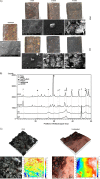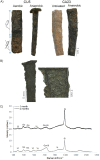Remedial Treatment of Corroded Iron Objects by Environmental Aeromonas Isolates
- PMID: 30478230
- PMCID: PMC6344634
- DOI: 10.1128/AEM.02042-18
Remedial Treatment of Corroded Iron Objects by Environmental Aeromonas Isolates
Abstract
Using bacteria to transform reactive corrosion products into stable compounds represents an alternative to traditional methods employed in iron conservation. Two environmental Aeromonas strains (CA23 and CU5) were used to transform ferric iron corrosion products (goethite and lepidocrocite) into stable ferrous iron-bearing minerals (vivianite and siderite). A genomic and transcriptomic approach was used to analyze the metabolic traits of these strains and to evaluate their pathogenic potential. Although genes involved in solid-phase iron reduction were identified, key genes present in other environmental iron-reducing species are missing from the genome of CU5. Several pathogenicity factors were identified in the genomes of both strains, but none of these was expressed under iron reduction conditions. Additional in vivo tests showed hemolytic and cytotoxic activities for strain CA23 but not for strain CU5. Both strains were easily inactivated using ethanol and heat. Nonetheless, given a lesser potential for a pathogenic lifestyle, CU5 is the most promising candidate for the development of a bio-based iron conservation method stabilizing iron corrosion. Based on all the results, a prototype treatment was established using archaeological items. On those, the conversion of reactive corrosion products and the formation of a homogenous layer of biogenic iron minerals were achieved. This study shows how naturally occurring microorganisms and their metabolic capabilities can be used to develop bio-inspired solutions to the problem of metal corrosion.IMPORTANCE Microbiology can greatly help in the quest for a sustainable solution to the problem of iron corrosion, which causes important economic losses in a wide range of fields, including the protection of cultural heritage and building materials. Using bacteria to transform reactive and unstable corrosion products into more-stable compounds represents a promising approach. The overall aim of this study was to develop a method for the conservation and restoration of corroded iron items, starting from the isolation of iron-reducing bacteria from natural environments. This resulted in the identification of a suitable candidate (Aeromonas sp. strain CU5) that mediates the formation of desirable minerals at the surfaces of the objects. This led to the proof of concept of an application method on real objects.
Keywords: Aeromonas; artifacts; corrosion; iron; reduction; vivianite.
Copyright © 2019 Kooli et al.
Figures




Similar articles
-
Use of Bacteria To Stabilize Archaeological Iron.Appl Environ Microbiol. 2017 Apr 17;83(9):e03478-16. doi: 10.1128/AEM.03478-16. Print 2017 May 1. Appl Environ Microbiol. 2017. PMID: 28283522 Free PMC article.
-
Bacterial iron reduction and biogenic mineral formation for the stabilisation of corroded iron objects.Sci Rep. 2018 Jan 15;8(1):764. doi: 10.1038/s41598-017-19020-3. Sci Rep. 2018. PMID: 29335593 Free PMC article.
-
Orenia metallireducens sp. nov. Strain Z6, a Novel Metal-Reducing Member of the Phylum Firmicutes from the Deep Subsurface.Appl Environ Microbiol. 2016 Oct 14;82(21):6440-6453. doi: 10.1128/AEM.02382-16. Print 2016 Nov 1. Appl Environ Microbiol. 2016. PMID: 27565620 Free PMC article.
-
Mini-review: the morphology, mineralogy and microbiology of accumulated iron corrosion products.Biofouling. 2014 Sep;30(8):941-8. doi: 10.1080/08927014.2014.951039. Biofouling. 2014. PMID: 25271874 Free PMC article. Review.
-
Metabolic processes applied to endangered metal and wood heritage objects: Call a microbial plumber!N Biotechnol. 2020 May 25;56:21-26. doi: 10.1016/j.nbt.2019.11.003. Epub 2019 Nov 6. N Biotechnol. 2020. PMID: 31706044 Review.
Cited by
-
Multilocus sequence typing and antibiotic resistance of Aeromonas isolated from freshwater fish in Hebei Province.PLoS One. 2024 Mar 27;19(3):e0298745. doi: 10.1371/journal.pone.0298745. eCollection 2024. PLoS One. 2024. PMID: 38536889 Free PMC article.
-
The Bad and the Good-Microorganisms in Cultural Heritage Environments-An Update on Biodeterioration and Biotreatment Approaches.Materials (Basel). 2021 Jan 1;14(1):177. doi: 10.3390/ma14010177. Materials (Basel). 2021. PMID: 33401448 Free PMC article. Review.
-
Conditional Forest Models Built Using Metagenomic Data Accurately Predicted Salmonella Contamination in Northeastern Streams.Microbiol Spectr. 2023 Mar 22;11(2):e0038123. doi: 10.1128/spectrum.00381-23. Online ahead of print. Microbiol Spectr. 2023. PMID: 36946722 Free PMC article.
-
Investigation of Biogenic Passivating Layers on Corroded Iron.Materials (Basel). 2020 Mar 6;13(5):1176. doi: 10.3390/ma13051176. Materials (Basel). 2020. PMID: 32155722 Free PMC article.
References
-
- Goral A. 2011. Research on cultural tourism development in sacral and spiritual sites from the UNESCO World Heritage List. Int J Herit Sustain Dev 1:49–59.
-
- Watkinson D, Lewis M. 2004. SS Great Britain iron hull: modelling corrosion to define storage relative humidity, p 88–102. In Ashton J, Hallam D (ed), Metal 04: proceedings of the International Conference on Metals Conservation. National Museum of Australia, Canberra, ACT, Australia.
Publication types
MeSH terms
Substances
LinkOut - more resources
Full Text Sources
Other Literature Sources
Medical
Molecular Biology Databases

